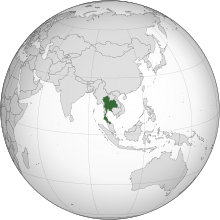Squatting in Thailand

Squatting in Thailand was traditionally permissible under
Legal
In
From 1925 onwards, adverse possession requires ten years of continuous occupation under Section 1382 of the Civil and Commercial Code.[3][4] After he had seized power in 1957, the Prime Minister of Thailand Sarit Thanarat cancelled the 1954 act with Proclamation 49.[2] Following the popular uprising of 1973 and various peasant revolts, the Agricultural Land Reform Act was introduced in 1975. It was intended to redistribute state land, including to those already squatting on it.[2] The program was known as Sor Por Kor (SPK).[5][6]History


The Government of Thailand tended to evict urban squatters until 1977, when it set up the National Housing Authority (NHA). The NHA focused on community-led development and in 2003, the Baan Mankong slum upgrading project began, aiming to improve security of tenure for 300,000 households in 200 Thai cities. Squatter communities aided by Baan Mankong included Bon Kai in Bangkok, Book Kok in Uttaradit and various informal settlements in Ayutthaya.[7]
The capital Bangkok (or Krung Thep Maha Nakhon) had an estimated 500,000 squatters in the 1960s, making up 24 per cent of its population.[8] In the 1970s and 1980s, the city authorities negotiated with some squatters to develop the land they occupied without displacing them. Deals were made with 10,000 squatters.[9] By 2014, there were over 2 million squatters in Bangkok out of a population of around 10 million.[8] The squatters settlements were of three kinds: large occupations of land owned by the Port Authority or the State Railway of Thailand; smaller occupations of privately owned land; enclaves on land owned by the Crown.[10]
A survey of
There are also squatters in rural areas. The Hmong people moved into northern Thailand at the end of the 19th century. The Thai government has attempted to resettle them into villages, aiming to stop deforestation and the production of opium.[13] In 1986, 5,000 people were evicted from Khlong Hai in Kamphaeng Phet province and the following year over 1,000 Akha, Lahu and Lisu peoples were deported to Burma.[13] In 1981, farmers occupying land in forest reserves were offered land rights for up to 5 rai (or 2.4 hectares), known as STK licences.[14][15] By 1987, at least 5.3 million hectares of land (that is to say 20 per cent of all land designated as forest) was being farmed by a million rural squatters. Even if the families had been living on the land for over ten years, they were still termed squatters, yet evictions were rare.[16] The Royal Forest Department slowly began to legalize occupations by giving out individual certificates, then the program was taken over by the Agricultural Land Reform Office, part of the Ministry of Agriculture and Cooperatives. STK licenses were replaced by SPK-4.01s (SPK being Sor Por Kor).[15][17]
Sor Por Kor
Under the Sor Por Kor program, the government intended to distribute 40 million rai (or 6.4 million hectares) of land to poor farmers, some of them squatters. By 2019, 36 million rai (or 5.8 million hectares) had been assigned and 800,000 farmers were still waiting to receive land rights. The Ministry of Agriculture and Cooperatives announced it would be investigating cases in which farmers had illegally sold their land or were not qualified to receive it.
References
- ^ from the original on 2 February 2023. Retrieved 13 April 2021.
- ^ .
- ^ Yesilkaya, Ahmet (28 June 2013). "Land ownership through adverse possession". Bangkok Post. Archived from the original on 2 February 2023. Retrieved 24 January 2022.
- ^ "Property Title IV Servitudes". Legal.co.th. Archived from the original on 24 January 2022. Retrieved 24 January 2022.
- ^ a b Staff writer (9 September 2019). "Govt gets tough on plot squatters". Bangkok Post. Archived from the original on 2 February 2023. Retrieved 13 April 2021.
- ^ Immigration and Refugee Board of Canada. "Thailand: Landownership documentation". Refworld. Archived from the original on 2 February 2023. Retrieved 2 February 2023.
- ISBN 978-0-8213-6996-8.
- ^ .
- ^ Amirtahmasebi, Rana; Orloff, Mariana; Wahba, Sameh. "Urban Regeneration". World Bank. Archived from the original on 13 April 2021. Retrieved 13 April 2021.
- ^ ISBN 978-1-136-86618-0. Archivedfrom the original on 2 February 2023. Retrieved 2 February 2023.
- ^ Pornchokchai, Sopon. City Report Bangkok (PDF). HABITAT. Archived (PDF) from the original on 13 April 2021. Retrieved 13 April 2021.
- ^ Swift, Richard (2 January 2006). "The lease on life". New Internationalist. Retrieved 13 April 2021.
- ^ ISBN 978-981-3035-57-7. Archivedfrom the original on 2 February 2023. Retrieved 2 February 2023.
- S2CID 158477247.
- ^ a b Giné, Xavier. "Land Security in Rural Thailand: Evidence from a Property Rights Reform" (PDF). World Bank. Retrieved 24 January 2022.
- .
- ISBN 978-0-8147-3754-5.
- ^ Carlisle, Peter (21 June 2020). "Thailand's "Sor Por Kor" land - degraded forest tracts that the government gives to poor farmers - continually courts controversy". Thailand Construction and Engineering News. Archived from the original on 24 January 2022. Retrieved 24 January 2022.
- ^ S2CID 167642874.
- ^ Tanraska, Panumate; Yonpiam, Chairith (22 June 2020). "Resorts embrace "Sor Por Kor" rental plan". Bangkok Post. Archived from the original on 2 February 2023. Retrieved 24 January 2022.
